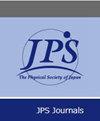易感-感染-恢复-易感模型中的重复感染传播和定向进化
IF 2.2
4区 物理与天体物理
Q2 PHYSICS, MULTIDISCIPLINARY
引用次数: 0
摘要
我们研究了两种简单的流行病数学模型。首先,我们研究了简化的易感-感染-恢复-易感(SIRS)模型中的重复感染传播,包括获得性免疫衰减的影响。该模型是包括招募和死亡项的 SIRS 模型和假设康复人群不再受感染的 SIR 模型的中间产物。当获得性免疫的衰减率δ足够低时,多重感染传播会以尖峰形式出现。当衰减率δ足够低时,模型方程可简化为一个映射,在映射中再现了尖峰状的多重感染扩散。在具有季节变化的简化 SIRS 模型中发现了周期加倍分岔和混沌现象。非线性现象通过映射得以重现。接下来,我们研究了定向演化的 SIRS 耦合方程,其中突变用扩散型项表示。感染率与类型空间线性相关的反应扩散方程有一个精确的高斯解,其平均值和方差随时间变化。高斯脉冲的传播与主导变体的连续转变相对应。本文章由计算机程序翻译,如有差异,请以英文原文为准。
Repetitive Infection Spreading and Directed Evolution in the Susceptible–Infected–Recovered–Susceptible Model
We study two simple mathematical models of an epidemic. First, we study the repetitive infection spreading in a simplified susceptible–infected–recovered–susceptible (SIRS) model including the effect of the decay of the acquired immunity. The model is an intermediate of the SIRS model including the recruitment and death terms and the SIR model in which the recovered population is assumed to be never infected again. When the decay rate δ of the acquired immunity is sufficiently low, multiple infection spreading occurs in spikes. The model equation can be reduced to a map when the decay rate δ is sufficiently low, and the spike-like multiple infection spreading is reproduced in the mapping. The period-doubling bifurcation and chaos are found in the simplified SIRS model with seasonal variations. The nonlinear phenomena are reproduced using the map. Next, we study coupled SIRS equations for the directed evolution where the mutation is expressed with a diffusion-type term. A type of reaction–diffusion equation is derived by the continuum approximation for the infected population I. The reaction–diffusion equation with the linear dependence of infection rate on the type space has an exact Gaussian solution with a time-dependent average and variance. The propagation of the Gaussian pulse corresponds to the successive transitions of the dominant variant.
求助全文
通过发布文献求助,成功后即可免费获取论文全文。
去求助
来源期刊
CiteScore
3.40
自引率
17.60%
发文量
325
审稿时长
3 months
期刊介绍:
The papers published in JPSJ should treat fundamental and novel problems of physics scientifically and logically, and contribute to the development in the understanding of physics. The concrete objects are listed below.
Subjects Covered
JPSJ covers all the fields of physics including (but not restricted to)
Elementary particles and fields
Nuclear physics
Atomic and Molecular Physics
Fluid Dynamics
Plasma physics
Physics of Condensed Matter
Metal, Superconductor, Semiconductor, Magnetic Materials, Dielectric Materials
Physics of Nanoscale Materials
Optics and Quantum Electronics
Physics of Complex Systems
Mathematical Physics
Chemical physics
Biophysics
Geophysics
Astrophysics.

 求助内容:
求助内容: 应助结果提醒方式:
应助结果提醒方式:


